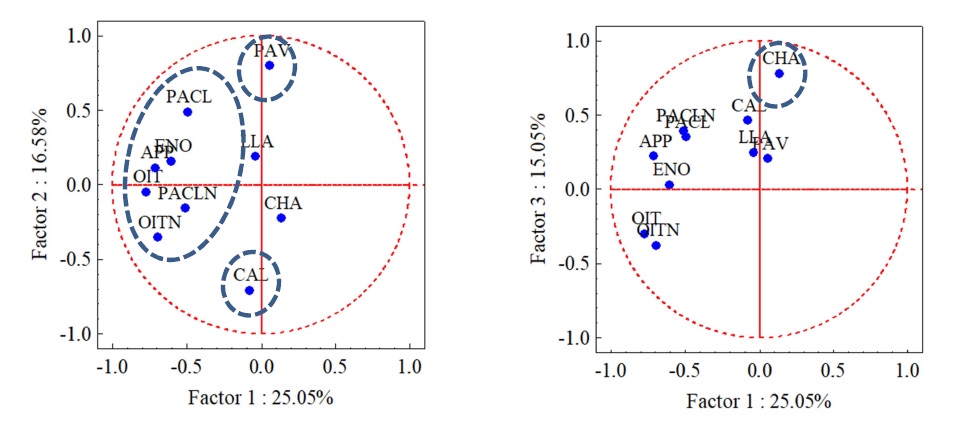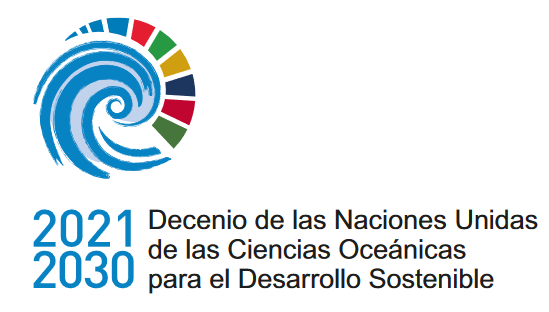Relación entre los cambios a largo plazo de la comunidad de zooplancton y la variabilidad ambiental en la estación EPEA (Océano Atlántico Sudoccidental)
DOI:
https://doi.org/10.47193/mafis.3422021010610Palabras clave:
microzooplancton, mesozooplancton, serie temporal, estación EPEA, plataforma bonaerense, Atlántico SudoccidentalResumen
En las últimas décadas se ha registrado un aumento significativo de la temperatura superficial del mar en el Océano Atlántico Sudoccidental, entre 20° S-50° S. Los organismos del zooplancton son muy sensibles al aumento de la temperatura. Ellos cumplen un rol muy importante en los ecosistemas marinos dado que constituyen la principal vía de transferencia de energía desde los productores primarios a los consumidores. En este trabajo se analizó la variabilidad estacional e interanual (2000-2017) del metazooplancton en la estación EPEA (38° 28′ S-57° 41′ W), en relación con los cambios ambientales, en particular de la temperatura. Copépodos, apendicularias, cladóceros, quetognatos y larvas de lamelibranquios fueron identificados y cuantificados. La temperatura exhibió una tendencia interanual positiva de las anomalías durante la serie mientras que el parámetro de Simpson mostró una tendencia decreciente y la salinidad prácticamente se mantuvo invariable. Adultos, copepoditos, y nauplii de los copépodos pequeños pertenecientes a las familias Oithonidae (en su mayoría Oithona nana) y Paracalanidae-Clausocalanidae dominaron la comunidad del metazooplancton durante el período de estudio. Se identificaron claramente tres grupos de taxa con diferentes patrones estacionales de variabilidad. Miembros de la Familia Oithonidae exhibieron tendencias interanuales positivas mientras que las larvas de lamelibranquios y la Familia Calanidae mostraron tendencias interanuales decrecientes. Se sugiere un efecto directo de las anomalías de la temperatura sobre estas variaciones así como posibles efectos indirectos de este parámetro sobre el zooplancton, a través de su influencia sobre diferentes fracciones del fitoplancton. En el actual escenario de cambio climático, el mantenimiento de esta serie temporal es de gran importancia para evaluar la transferencia eventual de la variabilidad ambiental a la trama trófica local a través del plancton.
Descargas
Referencias
Atienza D, Calbet A, Saiz E, Alcaraz M, Trepat I. 2006. Trophic impact, metabolism, and biogeochemical role of the marine cladoceran Penilia avirostris and the co-dominant copepod Oithona nana in NW Mediterranean coastal waters. Mar Biol. 50: 221-235.
Beaugrand G, Kirby RR. 2018. How do marine pelagic species respond to climate change? Theories and observations. Ann Review Mar Sci. 10: 169-197.
Behrenfeld MJ, O’Malley RT, Siegel DA, McClain CR, Sarmiento JL, Feldman GC, Milligan AJ, Falkowski PG, Letelier RM, Boss ES. 2006. Climate-driven trends in contemporary ocean productivity. Nature. 444: 752-755.
Böttjer D, Morales CE, Bathmann U. 2010. Trophic role of small cyclopoid copepod nauplii in the microbial food web: a case study in the coastal upwelling system off central Chile. Mar Biol. 157: 689-705.
Bremec CM, Lasta M. 1998. Mapeo sinóptico del macrobentos asociado a la dieta en fondos de alimentación de la corvina rubia (Micropogonias furnieri) en el área de El Rincón. Noviembre, 1994. INIDEP Inf Téc. 21: 117-132.
Capitanio FL, Curelovich J, Tresguerres M, Negri RM, Viñas MD, Esnal G. 2008. Seasonal cycle of appendicularians at a coastal station (38°28′S, 57°41′W) of the SW Atlantic Ocean. B Mar Sci. 82:171-184.
Carreto JI, Akselman R, Montoya NG, Negri RM, Benavídes HR, Carignan MO, Cucchi Colleoni AD. 1998. Alexandrium tamarense Bloom dynamics and Mytilus edulis toxicity in the coastal waters off Mar del Plata (Argentina). In: Reguera B, Blanco J, Fernández MI, Wyatt T, editors. Harmful microalgae. Santiago de Compostela: Xunta de Galicia and IOC-UNESCO: 135-138.
Cepeda G. 2013. Sistemática molecular, distribución y dinámica poblacional de las especies de Oithona (Copepoda, Cyclopoida) en diversos sectores costeros del Mar Argentino [PhD thesis]. Mar del Plata: Facultad de Ciencias Exactas y Naturales, Universidad Nacional de Mar del Plata. 193 p.
Cepeda GD, Di Mauro RP, Hozbor MC, Cucchi Colleoni BD, Hernández D, Viñas MD. 2015. Spatial variation in life-history traits of Oithona spp. in a shallow temperate estuarine system (Río de la Plata, south-west Atlantic) during spring. Mar Freshwater Res. 66: 795-804.
Cepeda G, Temperoni B, Sabatini M, Viñas MD, Derisio C, Santos B, Antacli J, Padovani L. 2018. Zooplankton communities of the Argentine continental shelf (SW Atlantic, ca. 34°-55°S) an Overview. In: Hoffmeyer M, Sabatini M, Brandini F, Calliari D, Santinelli N, editors. Plankton ecology of the Southwestern Atlantic from the subtropical to the subantarctic realm. Springer. p. 171-200.
Daponte MC, Capitanio FL, Nahabedian DE, Viñas MD, Negri RM. 2004. Sagitta friderici Ritter-Zahony (Chaetognatha) from South Atlantic waters: abundance, population structure, and life cycle. ICES J Mar Sci. 61: 680-686.
Di Mauro R, Capitanio F, Viñas MD. 2009. Capture efficiency for small dominant mesozooplankters (Copepoda, Appendicularia) off Buenos Aires Province (34°S-41°S), Argentine Sea, using two plankton mesh sizes. Braz J Oceanogr. 57: 205-214.
Diosalvi N. 2006. Estudio del ciclo anual del mesozooplancton en una estación permanente ubicada en aguas costeras bonaerenses [tesis de grado]. Mar del Plata: Facultad de Ciencias Exactas y Naturales, Universidad Nacional de Mar del Plata. 48 p.
Edwards M, Richardson AJ. 2004. The impact of climate change on the phenology of the plankton community and trophic mismatch. Nature. 430: 881-884.
Edwards M, Beaugrand G, Hays GC, Koslow, JA, Richardson AJ. 2010. Multidecadal oceanic ecological datasets and their application in marine policy and management. Trends Ecol Evol. 25: 602-610.
Flood PR, Deibel D, Morris CC. 1992. Filtration of colloidal melanin from sea-water by planktonic tunicates. Nature. 355: 630-632.
Hays GC, Richardson AJ, Robinson C. 2005. Climate change and plankton. Trends Ecol Evol. 20: 337-344.
Henson SA. 2014. Slow science: the value of long ocean biogeochemistry records. Philos Trans R Soc A. 372. DOI: https://doi.org/10.1098/rsta.2013.0334
Hopcroft RR, Roff JC, Chavez FP. 2001. Size paradigms in copepod communities: a re-examination. Hydrobiologia. 453: 133-141.
[IPCC] Grupo Intergubernamental de Expertos sobre el Cambio Climático. 2019. El océano y la criosfera en un clima cambiante. Informe especial del Grupo Intergubernamental de Expertos sobre el Cambio Climático. Resumen para responsables de políticas. In: Pörtner HO, Roberts DC, Masson-Delmotte V, Zhai P, Tignor M, Poloczanska E, Mintenbeck K, Nicolai M, Okem A, Petzold J, Rama B, Weyer NM, editors. Geneva: IPCC. 38 p.
Jamet JL, Bogé G, Richard S, Geneys C, Jamet D. 2001. The zooplankton community in bays of Toulon area (northwest Mediterranean Sea, France). Hydrobiologia. 457: 155-165.
Kiørboe T, Ceballos S, Høgsbro Thygesen U. 2015. Interrelations between senescence, life-history traits, and behavior in planktonic copepods. Ecology. 96 (8): 2225-2235.
Lentini Cad, Campos EJD, Podestá GG. 2000. The annual cycle of satellite derived sea surface temperature on the western South Atlantic shelf. Rev Bras Oceanogr. 48 (2): 93-105.
Leonarduzzi E, Brown DR, Sánchez R. 2010. Seasonal variations in the growth of anchovy larvae (Engraulis anchoita) on the Argentine coastal shelf. Sci Mar. 74: 267-274.
Leonarduzzi E, Do Souto M, Diaz MV. 2021. Early stages of anchovy: abundance, variability and larval condition at the fixed coastal station EPEA between 2000-2017. Mar Fish Sci. 34 (2): 123-142.
Li WKW, Harrison WG. 2008. Propagation of an atmospheric climate signal to phytoplankton in a small marine basin. Limnol Oceanogr. 53: 1734-1745.
Luz Clara M, Simionato CG, Jaureguizar AJ. 2019. Annual variability of sea surface temperature in the northern Argentinean continental shelf. Geoacta. 43.
Mackas DL, Greve W, Edwards M, Chiba S, Tadokoro K, Eloire D, Mazzocchi MG, Batten S, Richardson A, Johnson C, et al. 2012. Changing zooplankton seasonality in a changing ocean: comparing time series of zooplankton phenology. Progr Oceanogr. 97-100: 31-62.
Mackas D, Thomson RE, Galbraith M. 2001. Covariation of zooplankton community changes and oceanographic conditions on the British Columbia continental margin, 1995-1998. Can J Fish Aquat Sci. 58: 1-18.
Madirolas A, Cabreira A, Hansen JE. 2013. Revisión y síntesis de las estimaciones acústicas de abundancia de anchoíta (Engraulis anchoita) efectuadas entre 1993 y 2008. Rev Invest Desarr Pesq. 23: 35-48.
Madsen SD, Nielsen TG, Hansen BW. 2008. Annual population development and production by small copepods in Disko Bay, western Greenland. Mar Biol. 155: 63-77.
Martínez-Avellaneda N. 2005. Ciclo anual y variabilidad de baja frecuencia de la temperatura superficial del mar en el Océano Atlántico Sudoccidental [tesis de licenciatura]. Buenos Aires: Facultad de Ciencias Exactas y Naturales, Universidad de Buenos Aires. 133 p.
Mauchline J. 1998. The biology of calanoid copepods. Adv Mar Biol. 33. 710 p.
Mazzocchi MG, Ribera D’Alcala M. 1995. Recurrent patterns in zooplankton structure and succession in a variable coastal environment. ICES J Mar Sci. 52: 679-691.
Moran XAG, López-Urruria A, Calvo-Diaz A, Li WKW. 2010. Increasing importance of small phytoplankton in a warmer ocean. Global Change Biol. 16: 1137-1144.
Muller Karger FE, Piola A, Verheye HM, O’Brien TD, Lorenzoni L. 2017. South Atlantic Ocean. In: O’Brien TD, Lorenzoni L, Isensee K, Valdés L, editors. What are Marine Ecological Time Series telling us about the ocean? A status report. IOC-UNESCO, IOC Tech Ser. 129: 83-96.
Negri R, Silva RI. 2003. Contribución de las distintas fracciones del fitoplancton a la biomasa fototrófica durante un ciclo anual en la estación EPEA (38° 28′ S-57° 41′ W). V Jornadas Nacionales de Ciencias del Mar. Mar del Plata, Argentina. 147.
Negri R, Silva RI. 2011. Estructura de la comunidad del fitoplancton en la estación costera EPEA durante el período 2000-2010 (provincia de Buenos Aires, Argentina). Bol Soc Argent Bot. 46 (Supl): 99-100.
O’Brien TD, López Urrutia A, Wiebe PH, Hay S. 2008. ICES Zooplankton Status Report 2006/2007. ICES Coop Res Rep. 292: 167 p.
O’Brien TD, Lorenzoni L, Isensee K, Valdés L, editors. 2017. What are Marine Ecological Time Series telling us about the ocean? A status report. IOC-UNESCO, IOC Tech Ser. 129 297 p.
O’Brien TD, Wiebe PH, Falkenhaug T, editors. 2013. ICES Zooplankton Status Report 2010/2011. ICES Coop Res Rep. 318: 208 p.
Paffenhöfer GA. 1993. On the ecology of marine cyclopoid copepods (Crustacea, Copepoda, Cyclopoida). J Plankton Res. 15: 37-55.
Penchaszadeh P. 1980. Ecología larvaria y reclutamiento del mejillón del Atlántico Suroccidental, Mytilus platensis D’Orbigny. Cah Biol Mar. 21:169-179.
Pittois SG, Shaw M, Fox CJ, Frid CL. 2009. A new fine-mesh zooplankton time series from the Dove sampling station (North Sea). J Plankton Res. 31: 337-343.
Podestá GP, Brown OB, Evans RH. 1991. The annual cycle of satellite-derived sea surface temperature in the Southwestern Atlantic Ocean. American Meteorological Society. J Climate. 4: 157-467.
Purcell JE, Sturdevant MV, Galt CP. 2004. A review of appendicularians as prey of invertebrate and fish predators. In: Gorsky G, Youngbluth MJ, Deibel D, editors. Response of marine ecosystems to global change. Ecological impact of appendicularians. Paris: Editions des Archives Contemporaines. 359-435.
Ramírez, FC. 1981. Zooplancton y producción secundaria. Parte I. Variación y distribución estacional de los copépodos. Contrib Inst Nac Invest Desarr Pesq (Mar del Plata) Nº 383: 202-212.
Reid PC, Valdés L. 2011. ICES status report on climate change in the North Atlantic. ICES Coop Res Rep. 310: 262 p.
Ribera D’Alcalá MR, Conversano F, Corato F, Licandro P, Mangoni O, Marino D, Mazzocchi MG, Modigh M, Motresor M, Nardella M, et al. 2004. Seasonal patterns in plankton communities in a pluriannual time series at a coastal Mediterranean site (Gulf of Naples): an attempt to discern recurrences and trends. Sci Mar. 68 (Suppl 1): 65-83.
Rice E, Stewart G. 2016. Decadal changes in zooplankton abundance and phenology of Long Island Sound reflect interacting changes in temperature and community composition. Mar Env Res. 120: 154-165.
Richardson AJ. 2008. In hot water: zooplankton and climate change. ICES J Mar Sci. 65: 279-295.
Risaro D. 2020 Las tendencias de largo plazo de la temperatura superficial del mar alrededor de Sudamérica y su posible impacto ecológico [PhD thesis]. Ciudad Autónoma de Buenos Aires: Facultad de Ciencias Exactas y Naturales, Universidad de Buenos Aires. 185 p.
Rodríguez F, Fernández E, Head RN, Harbour DS, Bratbak G, Heldal M, Harris RP. 2000. Temporal variability of viruses, bacteria, phytoplankton and zooplankton in the western English Channel off Plymouth. J Mar Biol Assoc UK. 80: 575-586.
Ruiz MG, Lutz VA, Segura V, Berghoff CF, Negri RM. 2020. The color of Epea: variability in the in situ bio-optical properties in the period 2000-2017. Mar Fish Sci. 33 (2): 205-225.
Sabatini ME, Martos P. 2002. Mesozooplankton features in a frontal area off northern Patagonia (Argentina) during spring 1995 and 1998. Sci Mar. 66 (3): 215-232.
Sánchez RP, Ciechomski JD. 1995. Spawning and nursery grounds of pelagic fish species in the sea-shelf off Argentina and adjacent areas. Sci Mar. 59: 455-478.
Sarmiento JL, Slater R, Barber R, Bopp L, Doney SC, Hirst AC, Kleypas J, Matear R, Mikolajewicz U, Monfray P. et al. 2004. Response of ocean ecosystems to climate warming. Global Biogeochem. Cycles. 18: GB3003. DOI: https://doi.org/10.1029/2003GB002134
Satapoomin S, Nielsen TG, Hansen PJ. 2004. Andaman-Sea copepods. Spatio-temporal variations in biomass and production and role in the pelagic food web. Mar Ecol Prog Ser. 274: 99-122.
Sato NE, Hernández D, Viñas MD. 2011a. Hábitos alimentarios de Sagitta friderici Ritter-Zahony, en las aguas costeras de la Provincia de Buenos Aires, Argentina. Bol Investig Mar Costeras. 40 (1): 59-74.
Sato NE, Hernández D, Viñas MD. 2011b. Hábitos alimentarios de las larvas de Engraulis anchoita (Hubbs & Marini, 1935) en las aguas costeras de la Provincia de Buenos Aires, Argentina. Lat Am J Aquat Res. 39: 16-24.
Silva RI. 2011. Dinámica del ultrafitoplancton en el Mar Argentino [PhD thesis]. Mar del Plata: Facultad de Ciencias Exactas y Naturales, Universidad Nacional de Mar del Plata. 187 p.
Silva RI, Negri RM, Lutz VA. 2009. Summer succession of ultraphytoplankton at the EPEA coastal station (Northern Argentina). J Plankton Res. 31 (4): 447-458.
Simpson JH. 1981. The shelf-sea fronts: implications of their existence and behavior. Phil Trans Roy Soc London A. 302: 531-546.
Siokou-Frangou I, Shiganova T, Christou ED, Kamburska L, Gubanova A, Konsulov A, Musaeva EI, Skryabin VA, Khoroshilov V. 2004. Mesozooplankton communities in the Aegean and Black seas: a comparative study. Mar Biol. 114: 111-126.
StatSoft, Inc. 2007. STATISTICA (data analysis software system), version 8.0. http://www.statsoft.com.
Temperoni B, Viñas MD, Diovisalvi NR, Negri RM. 2011. Seasonal production of Oithona nana Giesbrecht, 1893 (Copepoda: Cyclopoida) in temperate coastal waters off Argentina. J Plankton Res. 33: 729-740.
Tönnesson K, Maar M, Vargas C, Møller EF, Satapoomin S, Zervoudaki S, Christou E, Giannakourou A, Sell A, Petersen JK, et al. 2005. Grazing impact of Oikopleura dioica and copepods on an autumn plankton community. Mar Biol Res. 1: 365-373.
Turner JT. 2004. The importance of small planktonic copepods and their roles in pelagic marine food webs. Zool Stud. 43: 255-266.
Uye S, Shibuno N. 1992. Reproductive biology of the planktonic copepod Paracalanus sp. in the Inland Sea of Japan. J Plankton Res. 14: 343-358.
Valdés L, Lomas MW. 2017. New light for ship-based time series. In: O’Brien TD, Lorenzoni L, Isensee K, Valdés L, editors. What are Marine Ecological Time Series telling us about the ocean? A status report. IOC-UNESCO, IOC Tech Ser. 129: 11-17.
Viñas MD. 1990. Influence de la température sur la durée du développement d’Euterpina acutifrons (Copepoda: Harpacticoida) elevé au laboratoire. Mar Nat. 3: 29-35.
Viñas MD, Negri RM, Cepeda GD, Hernández D, Silva R, Daponte MC, Capitanio FL. 2013. Seasonal succession of zooplankton in coastal waters of the Argentine Sea (Southwest Atlantic Ocean): prevalence of classical or microbial food webs. Mar Biol Res. 9 (4): 371-382.
Viñas MD, Ramírez FC. 1996. Gut analysis of first-feeding anchovy larvae from Patagonian spawning area in relation to food availability. Arch Fish Mar Res. 43: 231-256.
Viñas MD, Ramírez FC, Santos B, Marrari M. 2007. Spatial and temporal distribution patterns of cladocerans in the Argentine Sea. Hydrobiologia. 594: 59-68.
Williams JA, Muxagata E. 2006. The seasonal abundance and production of Oithona nana Copepoda: Cyclopoida) in Southampton Water. J Plankton Res. 28: 1055-1065.
Zervoudaki S, Christou ED, Nielsen TG, Siokou-Frangou I, Assimakopoulou G, Giannakourou A, Maar M, Pagou K, Krasakopoulou E, Christaki U, et al. 2007. The importance of small-sized copepods in a frontal area of the Aegean Sea. J Plankton Res. 29: 317-338.

Descargas
Publicado
Número
Sección
Licencia
Derechos de autor 2021 María Delia Viñas, Georgina Cepeda, Moira Luz Clara

Esta obra está bajo una licencia internacional Creative Commons Atribución-NoComercial-CompartirIgual 4.0.
Los autores de los artículos publicados en Marine and Fishery Sciences conservan los derechos de autor de sus artículos, a excepción de las imágenes de terceros y otros materiales añadidos por Marine and Fishery Sciences, que están sujetos a los derechos de autor de sus respectivos propietarios. Por lo tanto, los autores son libres de difundir y volver a publicar sus artículos, sujeto a los requisitos de los propietarios de derechos de autor de terceros y sujeto a que la publicación original sea completamente citada. Los visitantes también pueden descargar y reenviar artículos sujetos a los requisitos de citas. La capacidad de copiar, descargar, reenviar o distribuir cualquier material siempre está sujeta a los avisos de derechos de autor que se muestran. Los avisos de copyright deben mostrarse de manera prominente y no pueden borrarse, eliminarse u ocultarse, total o parcialmente. El autoalmacenamiento en servidores y repositorios de preimpresión está permitido para todas las versiones.
Esta revista ofrece a los autores una política de acceso abierto. Los usuarios pueden leer, descargar, copiar, distribuir, imprimir, buscar o vincular los textos completos de los artículos, o usarlos para cualquier otro propósito legal dentro de la licencia Creative Commons 4.0 (BY-NC-SA), sin solicitar permiso previo del editor o del autor. Esto está de acuerdo con la definición BOAI de acceso abierto.























